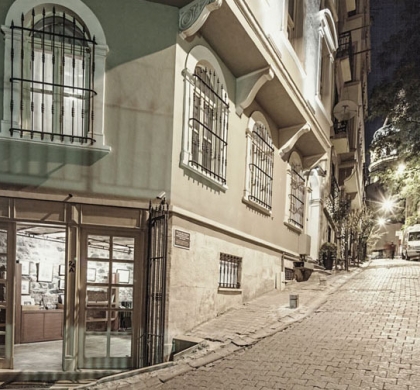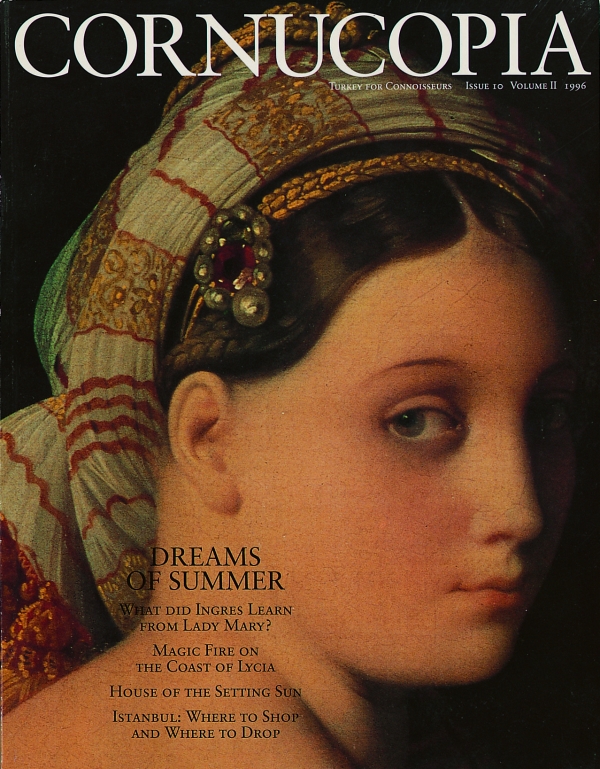Buy or gift a stand-alone digital subscription and get unlimited access to dozens of back issues for just £18.99 / $18.99 a year.
Please register at www.exacteditions.com/digital/cornucopia with your subscriber account number or contact subscriptions@cornucopia.net
Buy a digital subscription Go to the Digital EditionThe French novelist Pierre Loti caused a stir in the 1900s when he championed the cause of Turkish women. But just who were the three veiled women who gave him his information? Ömer Koç reports on an infamous literary deception
The East is a career, said Disraeli, and the life of Pierre Loti is a perfect example of Disraeli’s dictum. Just as he filled his house at Rochefort with exotica, so he crammed his writing career with novels set in a gamut of places stretching from Tahiti to Turkey, from Isfahan to Japan.
Loti’s first novel, Aziyadé, which he published anonymously in 1879, is set in Turkey. It tells of the love of an English naval officer stationed in Istanbul and a young Circassian woman married to a much older Turk. Aziyadé, which became popular both in France and in Turkey, endeared Loti to the Turks and vice versa. Except for Turkish food, Loti loved everything Turkish and proved an indefatigable friend of the country. He understood well the spirit of the Turks, and no writer, except perhaps Gautier in Constantinople, has so touchingly described the charm and beauty of Istanbul.
When Les Désenchantées, one of Loti’s later novels, also set in Turkey, was serialised in the Revue des Deux Mondes, it was an instant success. It is the story of three indomitable, over-educated, upper-class Turkish girls, two sisters and their cousin, who epitomised for Loti the suffereings and constraints of a traditional restricted way of life imposed on the new breed of Turkish women. When it was published in book form in 1906, it met with even greater success…
Perhaps the most important reason for the work’s popularity was the dramatic discovery that it was based on fact. In January 1906 two of the three women on whom Loti had modelled his heroines fled from Turkey, fearing that their identity would be disclosed. Although it was known that Loti’s novels were mainly autobiographical, there had always been some doubt as to what extent they were the result of his actual experience. Aziyadé was thought by many to be wholly imaginary. The flight of the two Turkish women fuelled the public’s curiosity and, by confirming the factual basis of the plot, ensured a dazzling reception for the book…
The story of Les Désenchantées is the story of a huge hoax…
He was the most prolific architect of all time and his legacy endures in the great mosques created for Süleyman the Magnificent. Yet, as Brian Sewell discovers, this contemporary of Michelangelo is barely known to the West. Brian Sewell admires his legacy. Photographs by Ara Güler.
The Mocan Yalı, in the pretty village of Kuzguncuk, half a mile upstream from Üsküdar, is relatively old, decidedly large and incontrovertibly pink. Sultans stayed in it, and Liszt played in it. The yalı was purchased by the Toprak family shortly after this article was published. The interior of the house was gutted and only the facade remains. The images published in this article are a unique historical record of a centuries-old house and were taken by David George for Cornucopia in 1992
The Golden Fleece, Trebizond, Sumela… Jeremy Jame’s itinerary in Turkey’s dramatic Black Sea Mountains promised a string of ancient wonders
From chestnuts to walnuts, from pistachios to pine kernels, they are a mainstay of Turkey’s celebrated cuisine. Berrin Torolsan unearths some splendid traditional nut recipes.
More cookery features
Unlike the much older Venice Biennale, at the Istanbul Biennial there was a feeling of youthful experimentation.
A storm one cold winter’s day in Rome brought Jean-Etienne Liotard to Istanbul. In a café where he took refuge from the rain, he met an Englishman, William Ponsonby, the future Earl of Bessborough, who invited the painter to join his party on a tour of the East. Liotard accepted, and they set sail from Naples on April 3, 1738.
The relentless bombing of Mostar (1992) is destroying the fruits of five centuries of peaceful coexistance in Bosnia. Marian Wenzel recalls how the old Ottoman city looked when she lived there in the Sixties
Exquisite bulbs, once uprooted in their millions, may be saved by a scheme to satisfy both gardeners and conservationists. Botanist Andrew Byfield reports





Cornucopia works in partnership with the digital publishing platform Exact Editions to offer individual and institutional subscribers unlimited access to a searchable archive of fascinating back issues and every newly published issue. The digital edition of Cornucopia is available cross-platform on web, iOS and Android and offers a comprehensive search function, allowing the title’s cultural content to be delved into at the touch of a button.
Digital Subscription: £18.99 / $18.99 (1 year)
Subscribe now